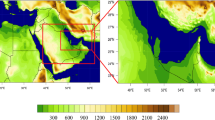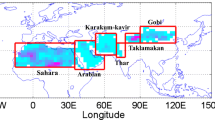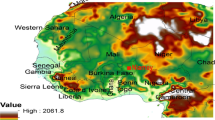Abstract
Dust aerosols make a considerable contribution to the climate system and atmospheric hydrological cycle through their radiative and ice nuclei effects. This underlines the need for investigating the sources of dust aerosols, their transport pathways, and radiative forcing. Seasonal distribution of mineral dust around the globe and its impact on radiation fluxes is estimated using two simulations: a model setup that did not include dust aerosols; and an interactive experiment that included dust aerosols and their feedback to the atmosphere. Simulations were performed by the Weather Research and Forecasting with Chemistry (WRF-Chem) model for a 1-year period. The global annual mean dust optical depth (DOD) at 0.55 \(\upmu\)m is estimated to be 0.057, with a spring peak value of 0.081 and an autumn minimum value of 0.039. Seasonal variation of atmospheric dust loading is shown to be associated with similar significant variation in shortwave and longwave direct radiation perturbation by dust, both at the surface and top of the atmosphere (TOA). The presence of mineral dust in the interactive simulation is estimated to exert a maximum net direct radiation perturbation in summer with values of \(-\)2.85 and \(-\)1.63 W m\(^{-2}\) in clear-sky conditions at the surface and TOA, respectively. It also exerts a global annual net direct radiation perturbation of \(-\)1.86 and \(-\)1.09 W m\(^{-2}\) at the surface and TOA, respectively. The surface cooling is attributed to the extinction of incoming solar radiation by dust aerosols, while negative perturbation at the TOA (which demonstrates cooling of the Earth-atmosphere system) is predominantly attributed to an increase in outgoing shortwave radiation.








Similar content being viewed by others
References
Ackermann IJ, Hass H, Memmesheimer M, Ebel A, Binkowski FS, Shankar U (1998) Modal aerosol dynamics model for Europe: development and first applications. Atmos Environ 32:2981–2999
Alizadeh Choobari O, Zawar-Reza P, Sturman A (2012) Feedback between windblown dust and planetary boundary-layer characteristics: sensitivity to boundary and surface layer parameterizations. Atmos Environ 61:294–304. doi:10.1016/j.atmosenv.2012.07.038
Alizadeh-Choobari O, Zawar-Reza P, Sturman A (2014) The global distribution of mineral dust and its impacts on the climate system: a review. Atmos Res 138:152–165. doi:10.1016/j.atmosres.2013.11.007
Balkanski YJ, Jacob DJ, Gardner GM, Graustein WC, Turekian KK (1993) Transport and residence times of tropospheric aerosols inferred from a global three-dimensional simulation of 210Pb. J Geophys Res 98(D11):20573–20586
Binkowski FS, Shankar U (1995) The regional particulate matter model 1. Model description and preliminary results. J Geophys Res 100(D12):26191–26209
Bory AJM, Biscaye PE, Grousset FE (2003) Two distinct seasonal Asian source regions for mineral dust deposited in Greenland (NorthGRIP). Geophys Res Lett 30(4):1167
Chapman EG, Gustafson WI, Easter RC, Barnard JC, Ghan SJ, Pekour MS, Fast JD (2009) Coupling aerosol-cloud-radiative processes in the WRF-Chem model: investigating the radiative impact of elevated point sources. Atmos Chemis Phys 9(3):945–964
Chen F, Dudhia J (2001) Coupling an advanced land surface-hydrology model with the Penn State-NCAR MM5 modeling system. Part I: Model implementation and sensitivity. Mon Weather Rev 129(4):569–585
Chiapello I, Bergametti G, Chatenet B, Dulac F, Jankowiak I, Liousse C, Soares ES (1999) Contribution of the different aerosol species to the aerosol mass load and optical depth over the northeastern tropical Atlantic. J Geophys Res 104(D4):4025–4035
Claquin T, Schulz M, Balkanski Y, Boucher O (1998) Uncertainties in assessing radiative forcing by mineral dust. Tellus B 50(5):491–505
Dubovik O, Holben B, Eck TF, Smirnov A, Kaufman YJ, King MD, Tanre D, Slutsker I (2002) Variability of absorption and optical properties of key aerosol types observed in worldwide locations. J Atmos Sci 59(3):590–608
Durant AJ, Harrison SP, Watson IM, Balkanski Y (2009) Sensitivity of direct radiative forcing by mineral dust to particle characteristics. Progress Phys Geog 33(1):80–102. doi:10.1177/0309133309105034
Easter RC, Ghan SJ, Zhang Y, Saylor RD, Chapman EG, Laulainen NS, Abdul-Razzak H, Leung LR, Bian X, Zaveri RA (2004) MIRAGE: Model description and evaluation of aerosols and trace gases. J Geophys Res 109(D20):D20210
Ek MB, Mitchell KE, Lin Y, Rogers E, Grunmann P, Koren V, Gayno G, Tarpley JD (2003) Implementation of Noah land surface model advances in the National Centers for Environmental Prediction operational mesoscale Eta model. J Geophys Res 108(D22):8851. doi:10.1029/2002JD003296
Ferek RJ, Liu QF, Albrecht BA, Babb D, Garrett T, Hobbs PV, Strader S, Johnson D, Taylor JP, Nielsen K, Ackerman AS, Kogan Y (2000) Drizzle suppression in ship tracks. J Atmos Sci 57(16):2707–2728
Ginoux P, Chin M, Tegen I, Prospero JM, Holben B, Dubovik O, Lin SJ (2001) Sources and distributions of dust aerosols simulated with the GOCART model. J Geophys Res 106(D17):20255–20273. doi:10.1029/2000JD000053
Ginoux P, Prospero JM, Torres O, Chin M (2004) Long-term simulation of global dust distribution with the GOCART model: correlation with North Atlantic Oscillation. Environ Model Software 19(2):113–128
Ginoux PA, Prospero JM, Gill TE, Hsu C, Zhao M (2012) Global-scale attribution of anthropogenic and natural dust sources and their emission rates based on MODIS Deep Blue aerosol products. Rev Geophys 50:RG3005. doi:10.1029/2012RG000388
Grell G, Peckham S, Schmitz R, McKeen S, Frost G, Skamarock W, Eder B (2005) Fully coupled “online” chemistry within the WRF model. Atmos Environ 39(37):6957–6975
Grell GA (1993) Prognostic evaluation of assumptions used by cumulus parameterizations. Mon Weather Rev 121(3):764–787
Grousset FE, Ginoux P, Bory A, Biscaye PE (2003) Case study of a Chinese dust plume reaching the French Alps. Geophys Res Lett 30(6):1277
Gunn R, Phillips BB (1957) An experimental investigation of the effect of air pollution on the initiation of rain. J Meteorol 14(3):272–280
Heintzenberg J (2009) The SAMUM1 experiment over Southern Morocco: overview and introduction. Tellus B 61(1):2–11
Hong SY (2010) A new stable boundary-layer mixing scheme and its impact on the simulated East Asian summer monsoon. Q J R Meteorol Soc 136(651):1481–1496
Hong SY, Noh Y, Dudhia J (2006) A new vertical diffusion package with an explicit treatment of entrainment processes. Mon Weather Rev 134(9):2318–2341
Huang J, Lin B, Minnis P, Wang T, Wang X, Hu Y, Yi Y, Ayers JK (2006) Satellite-based assessment of possible dust aerosols semi-direct effect on cloud water path over East Asia. Geophys Res Lett 33(L19):802. doi:10.1029/2006GL026561
Huneeus N, Schulz M, Balkanski Y, Griesfeller J, Prospero J, Kinne S, Bauer S, Boucher O, Chin M, Dentener F, Diehl T, Easter R, Fillmore D, Ghan S, Ginoux P, Grini A, Horowitz L, Koch D, Krol MC, Landing W, Liu X, Mahowald N, Miller R, Morcrette JJ, Myhre G, Penner J, Perlwitz J, Stier P, Takemura T, Zender CS (2011) Global dust model intercomparison in AeroCom phase I. Atmos Chemis Phys 11(15):7781. doi:10.5194/acp-11-7781-2011
Intergovernmental Panel On Climate Change (2001) Summary for policymakers: a report of working group I. In: Houghton JT et al (eds). Cambridge University Press, New York, p 881
Jickells TD, An ZS, Andersen KK, Baker AR, Bergametti G, Brooks N, Cao JJ, Boyd PW, Duce RA, Hunter KA, Kawahata H, Kubilay N, laRoche J, Liss PS, Mahowald N, Prospero JM, Ridgwell AJ, Tegen I, Torres R (2005) Global iron connections between desert dust, ocean biogeochemistry, and climate. Science 308(5718):67–71. doi:10.1126/science.1105959
Kim D, Chin M, Yu H, Diehl T, Tan Q, Kahn RA, Tsigaridis K, Bauer SE, Takemura T, Pozzoli L, Bellouin N, Schulz M, Peyridieu S, Chedin A, Koffi B (2014) Sources, sinks, and transatlantic transport of North African dust aerosol: a multimodel analysis and comparison with remote sensing data. J Geophys Res 119(10):6259–6277
Koren I, Kaufman YJ, Rosenfeld D, Remer LA, Rudich Y (2005) Aerosol invigoration and restructuring of Atlantic convective clouds. Geophys Res Lett 32(L14):828. doi:10.1029/2005GL023187
Koren I, Remer L, Altaratz O, Martins J, Davidi A (2010) Aerosol-induced changes of convective cloud anvils produce strong climate warming. Atmos Chemis Phys 10(10):5001–5010. doi:10.5194/acp-10-5001-2010
Li X, Maring H, Savoie D, Voss K, Prospero JM (1996) Dominance of mineral dust in aerosol light-scattering in the North Atlantic trade winds. Nature 380(6573):416–419
Liao H, Seinfeld JH (1998) Radiative forcing by mineral dust aerosols: sensitivity to key variables. J Geophys Res 103(D24):31637–31645. doi:10.1029/1998JD200036
Liou KN, Ou SC (1989) The role of cloud microphysical processes in climate: an assessment arom a one-dimensional perspective. J Geophys Res 94(D6):8599–8607
Luo C, Mahowald NM, del Corral J (2003) Sensitivity study of meteorological parameters on mineral aerosol mobilization, transport, and distribution. J Geophys Res 108(D15):4447
McCormick RA, Ludwig JH (1967) Climate modification by atmospheric aerosols. Science 156(3780):1358–1359
McGowan HA, Soderholm J (2012) Laser ceilometer measurements of Australian dust storm highlight need for reassessment of atmospheric dust plume loads. Geophys Res Lett 39(L02):804. doi:10.1029/2011GL050319
Miller RL, Tegen I (1998) Climate response to soil dust aerosols. J Clim 11(12):3247–3267
Miller RL, Tegen I, Perlwitz J (2004) Surface radiative forcing by soil dust aerosols and the hydrologic cycle. J Geophys Res 109(D04):203. doi:10.1029/2003JD004085
Mlawer EJ, Taubman SJ, Brown PD, Iacono MJ, Clough SA (1997) Radiative transfer for inhomogeneous atmospheres: RRTM, a validated correlated-k model for the longwave. J Geophys Res 102(D14):16663–16682
Morrison H, Thompson G, Tatarskii V (2009) Impact of cloud microphysics on the development of trailing stratiform precipitation in a simulated squall line: comparison of one- and two-moment schemes. Mon Weather Rev 137(3):991–1007
Obukhov AM (1971) Turbulence in an atmosphere with a non-uniform temperature. Bound Layer Meteorol 2(1):7–29
Perlwitz J, Tegen I, Miller RL (2001) Interactive soil dust aerosol model in the GISS GCM: 1. Sensitivity of the soil dust cycle to radiative properties of soil dust aerosols. J Geophys Res 106(D16):18167–18192. doi:10.1029/2000JD900668
Prospero JM, Ginoux P, Torres O, Nicholson S, Gill TE (2002) Environmental characterization of global sources of atmospheric soil dust identified with the Nimbus 7 Total Ozone Mapping Spectrometer (TOMS) absorbing aerosol product. Rev Geophys 40(1):1002
Richardson MI, Toigo AD, Newman CE (2007) Planetwrf: A general purpose, local to global numerical model for planetary atmospheric and climate dynamics. J Geophys Res 112(E09):001. doi:10.1029/2006JE002825
Rosenfeld D (2000) Suppression of rain and snow by urban and industrial air pollution. Science 287(5459):1793–1796
Schulz M, Textor C, Kinne S, Balkanski Y, Bauer S, Berntsen T, Berglen T, Boucher O, Dentener F, Guibert S, Isaksen ISA, Iversen T, Koch D, Kirkev A, Liu X, Montanaro V, Myhre G, Penner JE, Pitari G, Reddy S, Seland Stier P, Takemura T (2006) Radiative forcing by aerosols as derived from the AeroCom present-day and pre-industrial simulations. Atmos Chemis Phys 6(12):5225–5246
Sicard M, Bertoln S, Mallet M, Dubuisson P, Comer A (2014) Estimation of mineral dust long-wave radiative forcing: sensitivity study to particle properties and application to real cases in the region of Barcelona. Atmos Chemis Phys 14(17):9213–9231. doi:10.5194/acp-14-9213-2014
Skamarock WC, Klemp JB, Dudhia J, Gill DO, Barker DM, Duda MG, Huang X, Wang W, Powers JG (2008) A description of the advanced research WRF version 3, techincal report. Center for Atmospheric Research, Boulder
Sokolik I, Andronova A, Johnson TC (1993) Complex refractive index of atmospheric dust aerosols. Atmos Environ 27(16):2495–2502
Sokolik IN, Winker DM, Bergametti G, Gillette DA, Carmichael G, Kaufman YJ, Gomes L, Schuetz L, Penner JE (2001) Introduction to special section: Outstanding problems in quantifying the radiative impacts of mineral dust. J Geophys Res 106(D16):18015–18027
Stith JL, Ramanathan V, Cooper WA, Roberts GC, DeMott PJ, Carmichael G, Hatch CD, Adhikary B, Twohy CH, Rogers DC, Baumgardner D, Prenni AJ, Campos T, Gao R, Anderson J, Feng Y (2009) An overview of aircraft observations from the Pacific Dust Experiment campaign. J Geophys Res 114(D05):207. doi:10.1029/2008jd010924
Sullivan RC, Moore MJK, Petters MD, Kreidenweis SM, Roberts GC, Prather KA (2009) Effect of chemical mixing state on the hygroscopicity and cloud nucleation properties of calcium mineral dust particles. Atmos Chemis Phys 9(10):3303–3316
Tao WK, Chen JP, Li Z, Wang C, Zhang C (2012) Impact of aerosols on convective clouds and precipitation. Rev Geophys 50(2)
Tegen I, Lacis AA (1996) Modeling of particle size distribution and its influence on the radiative properties of mineral dust aerosol. J Geophys Res 101(D14):19237–19244
Tegen I, Harrison SP, Kohfeld K, Prentice IC, Coe M, Heimann M (2002) Impact of vegetation and preferential source areas on global dust aerosol: results from a model study. J Geophys Res 107(D21):4576
Textor C, Schulz M, Guibert S, Kinne S, Balkanski Y, Bauer S, Berntsen T, Berglen T, Boucher O, Chin M, Dentener F, Diehl T, Easter R, Feichter H, Fillmore D, Ghan S, Ginoux P, Gong S, Kristjansson J, Krol M, Lauer A, Lamarque J, Liu X, Montanaro V, Myhre G, Penner J, Pitari G, Reddy S, Seland O, Stier P, Takemura T, Tie X (2006) Analysis and quantification of the diversities of aerosol life cycles within Aerocom. Atmos Chemis Phys 6(7):1777–1813
Uno I, Sugimoto N, Eguchi K, Yumimoto K, Takemura T, Shimizu A, Uematsu M, Liu ZY, Wang ZF, Hara Y (2009) Asian dust transported one full circuit around the globe. Nature Geos 2(8):557–560. doi:10.1038/NGEO583
Wesely ML (1989) Parameterization of surface resistances to gaseous dry deposition in regional-scale numerical models. Atmos Environ 41:52–63
Woodage MJ, Woodward S (2014) U.K. HiGEM: impacts of desert dust radiative forcing in a high-resolution atmospheric GCM. J Clim 27(15):5907–5928. doi:10.1175/JCLI-D-13-00556.1
Woodward S (2001) Modeling the atmospheric life cycle and radiative impact of mineral dust in the Hadley Centre climate model. J Geophys Res 106(D16):18155–18166
Yoshioka M, Mahowald N, Conley A, Collins W, Fillmore D, Zender C, Coleman D (2007) Impact of desert dust radiative forcing on Sahel precipitation: relative importance of dust compared to sea surface temperature variations, vegetation changes, and greenhouse gas warming. J Climate 20(8):1445–1467
Yue X, Wang H, Wang Z, Fan K (2010) Simulation of dust aerosol radiative feedback using the GMOD: 2. Dust-climate interaction. J Geophys Res 114(D10):202. doi:10.1029/2009JD012063
Zaveri RA, Easter RC, Fast JD, Peters LK (2008) Model for simulating aerosol interactions and chemistry (MOSAIC). J Geophys Res 113(D13):204. doi:10.1029/2007JD008792
Zender CS, Bian H, Newman D (2003) Mineral Dust Entrainment and Deposition (DEAD) model: description and 1990s dust climatology. J Geophys Res 108(D14):4416
Zhang Y (2008) Online-coupled meteorology and chemistry models: history, current status, and outlook. Atmos Chem Phys 8(11):2895–2932
Zhang Y, Hemperly J, Meskhidze N, Skamarock WC (2012) The global Weather Research and Forecasting (GWRF) model: model evaluation, sensitivity study, and future year simulation. Atmos Clim Sci 2(3):231–253. doi:10.4236/acs.2012.23024
Zhao C, Liu X, Ruby Leung L, Hagos S (2011) Radiative impact of mineral dust on monsoon precipitation variability over West Africa. Atmos Chemis Phys 11(5):1879–1893. doi:10.5194/acp-11-1879-2011
Zhao C, Chen S, Leung LR, Qian Y, Kok J, Zaveri R, Huang J (2013) Uncertainty in modeling dust mass balance and radiative forcing from size parameterization. Atmos Chemis Phys 13(7):10733–10753. doi:10.5194/acp-13-10733-2013
Acknowledgments
The authors would like to thank the Foundation for Research, Science and Technology and the National Institute for Water and Atmospheric Research (New Zealand) for their financial support. This work has also benefited from access to the Bluefern supercomputer facilities at the University of Canterbury, New Zealand.
Author information
Authors and Affiliations
Corresponding author
Additional information
Responsible Editor: J. T. Fasullo.
Rights and permissions
About this article
Cite this article
Alizadeh-Choobari, O., Sturman, A. & Zawar-Reza, P. Global distribution of mineral dust and its impact on radiative fluxes as simulated by WRF-Chem. Meteorol Atmos Phys 127, 635–648 (2015). https://doi.org/10.1007/s00703-015-0390-4
Received:
Accepted:
Published:
Issue Date:
DOI: https://doi.org/10.1007/s00703-015-0390-4




